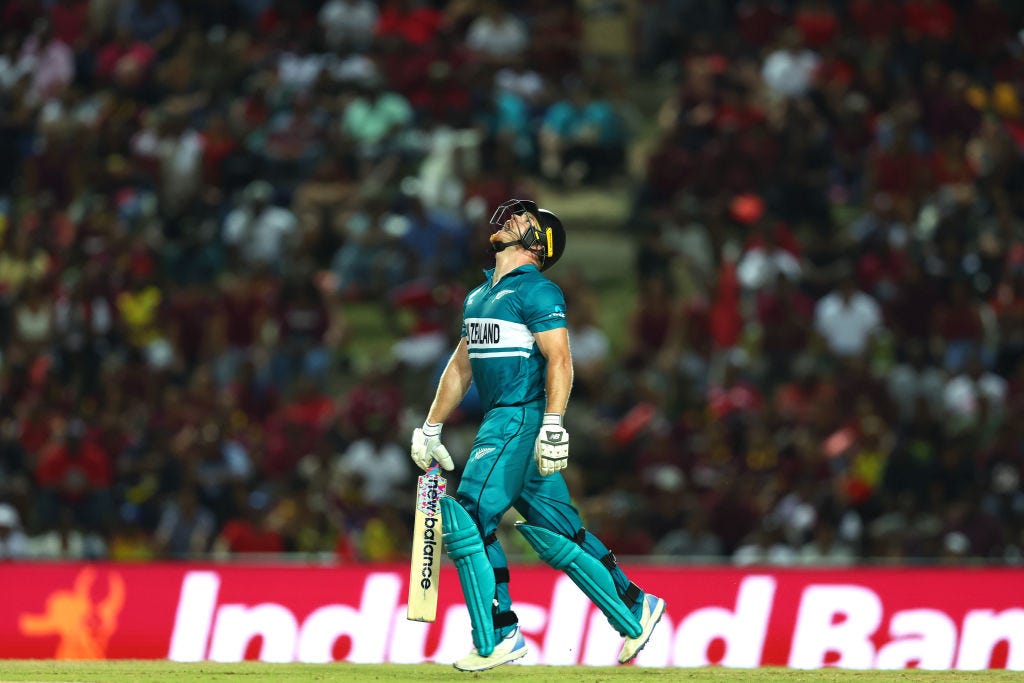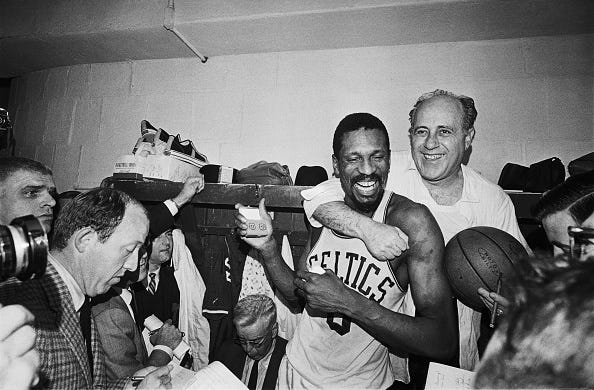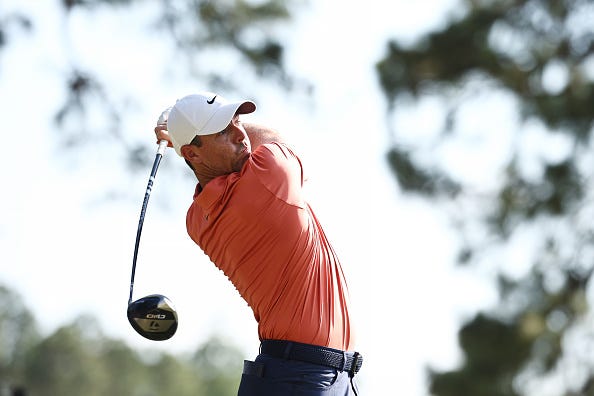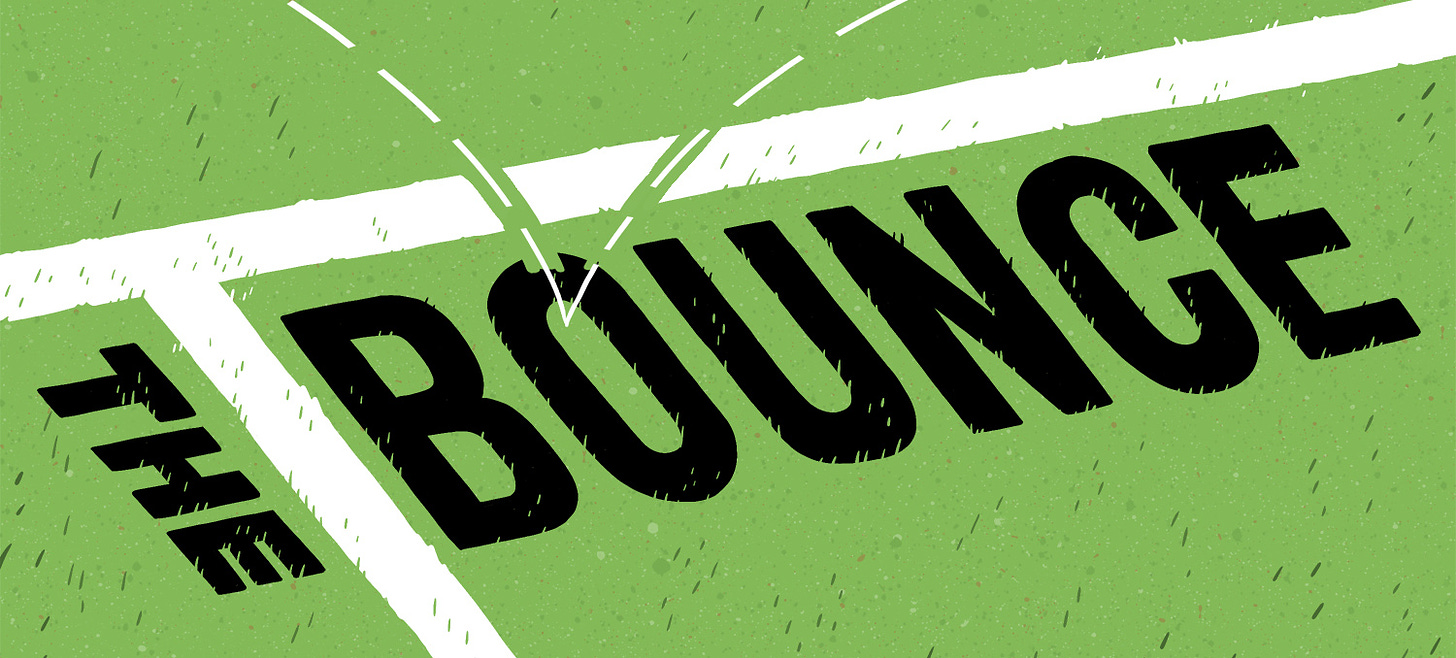Down and out in Trinidad
A fitting performance for a very bad day, PLUS: a profile redux and a busy Weekend That Will Be
Yesterday was my worst day of the year.
I mean that on a deeper level than “I stubbed my toe on the doorstep” or “I went to make toast and the Vogel’s was mouldy”, although the latter actually happened.
June 13 is a day I’ve grown to quietly and traditionally detest. It is a combination of my least favourite number (we’ll call it a mild case of triskaidekaphobia) in my least favourite month of my least favourite season. The only way it gets worse is the eight times in my life June 13 has fallen on a Tuesday, which is, by some distance, my least favourite day of the week.
But at least it’s over. As I push the publish button on this it is June 14. The shortest day of the year is exactly one week away, for me at least the year has already reached rock bottom. Things are slowly looking up.
For Gary Stead and Kane Williamson, it is still June 13 in the West Indies.
I suspect they’re not enjoying it much, either.
Losing to the West Indies in a T20 in their own conditions is in and of itself nothing to get wound up about.
There were a couple of galling aspects to the 13-run loss, but the big problem was the big picture, which looks something like this:
New Zealand took the piss out of this tournament and it ended up taking the piss out of them.
At this point it is pure speculation as to whether the blame lies mostly with management or a cabal of senior players, but unless somebody read their schedule back to front and thought they were starting the tournament with games against Papua New Guinea and Uganda, they made a conscious decision to go into their most important games of the World T20 with zero preparation. They looked at Afghanistan - a team with little depth but enough top-end talent to carry more than banana-skin potential - and thought, “a couple of throwdowns and she’ll be right”.
The whole campaign had Saturday morning at Karori Park vibes to it.
“Get yourself in a semicircle boys and I’ll slap some catches to you to warm those hands up. Dev, it’s your turn to grab the gloves, buddy.”
The first match in Guyana was an unmitigated disaster, which forced Stead and Kane Williamson to play an awkward game of catch-up in Trinidad.
The three changes to the playing XI were all justified and you could have made a case for four, but what it meant was you were switching out three players who had at least played a game of cricket in the Caribbean, for three who hadn’t.
If you’re coming into a tournament cold, you have to get your selections for your big games right. Swapping Matt Henry for Tim Southee, Michael Bracewell for James Neesham and Mark Chapman for Rachin Ravindra was a clear signal they got it wrong.
The game itself was won and lost between overs 15 and 20 of the first innings.
The 15th over was when Williamson brought back the impressive Southee for his fourth over, signalling that he didn’t like the Mitchell Santner-Sherfane Rutherford match-up and felt it was a seam-first wicket. He threw most of his eggs in the bowl-the-Windies-out-early basket.
You know what, with the West Indies at 81-7 at that point and 112-9 soon after, it’s hard to knock the decision. It was around about 58.3 percent justifiable.
Where the 41.7 comes in is that it was a misread of conditions, given the effectiveness of spinners Akeal Hosein and Gudakesh Motie (combined 4-46 off eight overs) later that evening and, most importantly, Santner or perhaps Glenn Phillips needed to have bowled a second over earlier in proceedings or else the maths didn’t work.
Choosing to go seam heavy and get 16 overs out of Southee, Trent Boult, Neesham and Lockie Ferguson is fine. Cobbling a fifth bowler out of a combination of Santner, Phillips and Daryl Mitchell is not ideal, when just one of them is world-class. Leaving that fifth bowler with both the 19th and 20th overs was hugely problematic. It’s hard to imagine any planning scenario where Daryl Mitchell was an option to bowl his first over in the 19th.
Those two overs cost 37 after Rutherford’s sensational intervention, and left New Zealand chasing 20 more than they should have.
They just didn’t bat well enough in pursuit of 150. In tough conditions they never looked likely.
Devon Conway sorted out one part of his game - and the grab to get Brandon King was a genuinely good catch, part-time keeper or not - but his batting (5 off 8) still looks miles from where it should be. Finn Allen flirted with an innings of significance (26 off 23), without ever looking likely to follow through, while Ravindra (10 off 13), Williamson (1 off 2, again nicking a back cut off a spinner with a slip in place), Mitchell (12 off 13) and Neesham (10 off 11), just batted their team into a hole that Phillips (40 off 33) could not dig them out of.
Game over. Tournament effectively over.
It will be interesting to see what the fallout will be.
They’re lucky in some respects that they have a couple of piñata in front of them before they come home. At least it will offer a bit of stats-padding.
Tim Paine said on Cricinfo that he felt England’s white-ball teams were “living in the past”. There is an element of that for New Zealand, particularly in the T20 space, where our domestic league is weak and we’re not getting enough players into good situations in the gold-standard IPL.
Even if Gary Stead has sat on the sidelines long past his best-before date, which is increasingly hard to argue against, New Zealand doesn’t have a whole bunch of can’t-miss players waiting in the wings for the next coach up.
After 10-15 years of ICC tournament over-achievement, perhaps they even saw this coming. I have lived in a house with a study-averse teenager and I haven’t heard as many pre-loaded excuses before exams as I’ve heard coming out of this camp.
It was a campaign framed by negativity, which was rewarded thus.
More reading:
Stuff go with a simple, but nice and droll intro:
They arrived late, and the Black Caps will almost certainly depart the Twenty20 World Cup early.
Radio NZ’s Morning Report digs into Stead’s future:
RNZ asked Stead if he was still the right person to be coaching the Black Caps.
“That’s a question you should be asking other people,” Stead told Morning Report.
“I can look at myself in the mirror and know that the preparation we tried to put in place has been as good as what’s capable of and all I can do is try and prepare the players to be ready for the games.”
Speaking live can mean words fall awkwardly out of your mouth, but the line emphasised above was very vague and slightly cryptic.
NZ v Uganda, Tarouba, tomorrow 12.30pm, SS 2 (ACC SS 9)
Profile v Feature, a sort of redux
One of the more unexpected and welcome additions to my week was a number of separate email threads in the wake of Monday’s newsletter I became engaged in that boiled down to a question: what constitutes a profile?
It’s a question without a fixed answer. The august New York Times offers a handy guide for aspiring profile writers, but it is predicated on the basis that the subject is a newsmaker, which I don’t agree with. Some excellent profiles are written because the subject is so damn interesting, not “newsworthy”.
Still, the NYT has some rules for profiles that are non-negotiable:
Interview with breadth and depth. Interview as wide a range of people as possible, and probe them for thoughtful answers. You don’t need to use quotes from every person you interview - but having a diverse collection of interviews in your notebook will give you the best possible selection of quotes. Plus, good interviews should help you expand your understanding of your topic.
This informs a lot of what I distinguish between a profile and a feature. A single-source interview (or an interview supplemented with patsy questions to the team’s comms person) does not make a profile. They’re feature interviews, often used as proxy previews for upcoming matches or events, and, if done well, are a valued part of the journalism canon and can be artful in themselves. If done badly they’re just turgid strings of quotes with anodyne linking paragraphs.
As an aside, this leads me to a quote that former Waikato Times man Bruce Holloway shared with me: “Too often the sports page profile could be summarised as people who couldn’t write interviewing people with nothing to say for the benefit of fans who could hardly read.” It’s repurposed from Tom Waits talking about music journalism, but hey… if the cap fits.
Back to the NYT, it suggests interviewing a minimum of five people, which sounds time consuming, but they don’t all need to be hourlong chats. They also have tips like:
Show, don’t tell. It is tempting to describe a room as messy or a person as nice. But carefully-observed details and well-chosen verbs make a much stronger impression than adjectives.
Put your story in context. You must help answer a reader’s biggest question about any story: Why should I care?
Don’t overuse direct quotes. Sometimes you can best capture a mood with your own prose. Think of direct quotes as icing on a cake - they enhance, but they shouldn’t form the substance of your story.
All handy enough writing tips, but not really finding the beating heart of what makes a great profile. So I turned to Duncan Greive, who probably penned my favourite New Zealand sports profile when tackling Kevin Fallon, a callused and complex subject.
He’s not the only coach ever to give an opponent a spray, but Fallon’s outbursts strike those around the game as different. More vicious, more frequent and more personal.
The high stakes of the Nationals seem to bring out the worst in him. A few years back he allegedly yelled at one player with a birth defect, “You should be playing in a circus, not playing football!” He called a heavier player “you fat cunt”.
Replied Greive to my query:
“There are many different scales of profile to me. [Steve] Braunias’ “Roosters I have known” was him writing a profile a week for a year, necessarily light of touch but still groaning with wit and insight. They’re rare and hard to pull off though.
“To me, profiles should ideally require more than one interview, along with talking/ reading around the subject, sometimes against their knowledge or will. The best versions will involve observation of the subject in the wild, in their world and ultimately advance a thesis of them - one you either discovered during the process or tested against reality. If it’s the latter, it should change along the way, otherwise you’re not looking hard enough.”
I definitely wrote a truckload more features than profiles, but one I got a kick out of was a portrait of my colleague, the inscrutable rugby scribe Wynne Gray.
That nose [for news] had been honed first at the Auckland Star in its 1970s heyday - Gray started as a cadet in 1975 - then by a stint in Sydney where he worked on a royal inquiry into organised crime. His most memorable story, however, was the tale of a boat that capsized off the Queensland coast. There were two survivors, several died.
“A rumour was percolating that the two survivors had used their colleagues as shark bait,” Gray recalls. “I had to ring one of them in hospital to inquire with as much subtlety as possible as to how the others ‘slipped’ off the wreckage.”
Gray brought Sydney’s ultra-competitive news sensibilities back to a New Zealand sports journalism scene that still revolved around lovingly compiled match reports.
Here’s two profiles I loved reading, with apologies if I have posted the first one before.
Frank Deford’s profile on the iconic Boston Celtic Bill Russell, one of sport’s greatest winners, was exceptional in that it broke all the rules. The writer inserted himself into the story not incidentally, but at the top and as a driver of the narrative. Who would even think to start a profile like this?
It was 30 years ago, and the car containing the old retired basketball player and the young sportswriter stopped at a traffic light on the way to the airport in Los Angeles. (Of course, in the nature of things, old players aren’t that much older than young writers.) The old player said, “I’m sorry, I’d like to be your friend.”
The young writer said, “But I thought we were friends.”
“No, I’d like to be your friend, and we can be friendly, but friendship takes a lot of effort if it’s going to work, and we’re going off in different directions in our lives, so, no, we really can’t be friends.”
And that was as close as I ever got to being on Bill Russell’s team.
I used to think about that drop-intro when I was a sports writing tadpole and wonder if I’d ever have the sort of relationship with a player or an athlete that would allow me to write something remotely similar, before concluding that even if I did, I’d never have the chutzpah to actually put in down in print.
Luke Foley posted this link in the comments below my Monday lament. It’s a profile about a table tennis player you’ve almost certainly never heard of, but it’s so good name recognition doesn’t matter.
For those of us hoping for drama from Marty himself, the worry is whether he is as confident as he says he is. There is the arm to take into consideration, the double loss to Jimmy Butler, and the inadequacy of what he has the gall to describe as “rigorous four-hour training sessions” with Steve Berger. I watch him bumble through his early rounds, tentative and out of touch, complaining about the light, the space, the floors, the conditions of modern life, but always doing just enough to get through. “I’m in a struggle to the death,” I hear him saying to himself, “with someone I could once give 15 points to.” And the truth is it’s that same knowledge on the part of his opponent that allows him through. Eye to eye with the possibility of beating Marty Reisman, most opponents cave in. He is the object of an almost universal veneration. Players from all over the world cross the hall to watch him, to beg an autograph, to tell him he is their lifelong hero, the reason they took up ping-pong in the first place. One by one, seeing me with a notepad in my hand, they repeat the tribute: “This guy’s a living legend, you know.” Wanting to be certain I’ve got that, Marty says, “You hear that, Howard? A living legend. Nice, huh?”
If you’ve read any brilliant profiles or, due to my narrow parameters, feature interviews, you think are worthy of highlighting here, feel free to make suggestions or send me links. I will continue to point to some of my favourites over the next few months.
The Weekend That Will Be
Just a few things you might want to get in front of the box for…
It’s a big weekend for Super Rugby after a low-key and predictable quarter-final round that excited the imaginations of few. Gregor Paul says the sport needs the Blues to win ($). Where he retains a sharp focus on rugby, it’s a solid argument. Just for style points and geographic ties, I’d probably prefer the eventual winner to come from the second semi, but if a Blues win wrenches the country’s largest city out of its dystopia - and as I look out my window rain is coming down in sheets with a very Blade Runner feel - then who am I to argue.
Rugby’s foothold in Auckland is tenuous and slipping and the sport’s inability to grow its footprint in a city with a population that is increasingly ethnically diverse, represents the wider challenge New Zealand Rugby has set itself by staking its commercial revival on a plan to win fans in offshore countries… In Auckland, rugby has to fight for players and eyeballs in a way that many provincial centres don’t, and it’s a fight it’s not really winning.
Blues v Brumbies, Auckland, tonight 7.05pm, SS 1 (ACC SS 9)
Hurricanes v Chiefs, Wellington, tomorrow 4.35pm, SS1 (ACC SS 9)
The Euros are about to start. I have zero idea who’s going to win, who’s had a good lead-up and who’s going to be knocked out on penalties - but I’m going to guess England for the last one. For no reason other than a soft spot for tartan, I’m adopting Scotland as my team.
The Guardian has an exhaustive bunch of preview links, and a portentous scene setter from Barney Ronay.
It is worth remembering political flux is a part of the heritage of the European Championship. This is a tournament forged around the wider urge for post-war European stability, the notion of football as an arm of international relations. The first edition in 1960 was won by the USSR, helped by a walkover after fascist Spain refused to travel to a communist country. Euro 88, the last one in West Germany, still feels indissolubly bound up with perestroika, the fall of the wall, Gorbachev and Reagan, the phrase “that was a different time”.
Now we have something different, a European championship in the shadow of a European land war, taking place 400 miles from Germany’s border, the equivalent of a match-day drive from Carlisle to Plymouth. The prime minister of Slovakia has been shot. Germany’s defence minister said this week the country needs to be “ready for war” by 2029. Europe is fringed with tension, toxic ally-ship and the fear of moving lines on the map. The 2006 World Cup had the strap-line “A Place to Make Friends”. How about this time we just go with A Place to Stop Threatening Each Other for a Bit.
Nice Barney, the time does seem right for a beautiful game distraction.
Germany v Scotland, Pool A, tomorrow 7am, TVNZ
Spain v Croatia, Pool B, Sunday 1am, TVNZ
Tough three-over start for Ryan Fox at the US Open on Michael Campbell’s former playground, Pinehurst No2. Good news for fans of Rory McIlroy and his marital status however. The three other times he has started majors with bogey-free rounds he has gone on to win. His five-under first-round was both blemish free and a celebration of his reconciliation with wife Erica.
Here’s a wrap of day one from ESPN, including this on Ludvig Aberg.
At this point, we probably shouldn’t be surprised by anything Åberg does on the golf course. After finishing second in his first Masters appearance in April, Aberg carded a 4 under 66 on Thursday, his US Open debut. Aberg is the seventh player in US Open history to post a 66 or better in his debut round.
By the way, Pinehurst is a ridiculous place. The Pinehurst Country Club has nine courses, but click this link, hit Google maps, switch to satellite mode, zoom in and you’ll see the entire area is just made up of golf courses, country clubs and pet resorts.
US Open, Pinehurst, tonight 11.35pm Sunday-Monday 2am, Sky channels
One of my Warriors dudes is trying to engage me in a bet for a mid-priced bottle of wine over the team’s prospects of making the top four. He says “no” and reckons forensic analysis of the remaining games sees his team sneaking into the top eight only. I’m still holding out hope because nobody is getting away on the ladder (case in point, the Dolphins beat the Sharks in Sydney in a thriller last night). I reckon I can put him off for a week before making the call because Melbourne at home shapes as a bellwether game. Win this and the past month has been no mirage. Lose and some of the insecurities of April will come flooding back.
NZ Warriors v Melbourne, Auckland, tomorrow 7.30pm, SS 4 (ACC SS 9)
The best-of-seven NBA and NHL finals continue, but for how much longer after the Boston Celtics (3-0) and Florida Panthers (2-0) threaten to make short work of the Dallas Mavericks and Edmonton Oilers respectively. The Oilers are trying to fight their way back into the series as I write. I’m not sure of its television status, but Maia Ramsden goes for the 1500m Olympic qualifying time of 4m 02.5s in Vancouver on Sunday afternoon (NZT). Meanwhile, the Pulse travel to Christchurch to meet the Tictax in a ANZ Premiership top-of-the-table clash, and when I say top-of-the-table, they are running away with it. Kiwis keep driving things, from the Supercars in Darwin (Sky), to Nascar Xfinity in Iowa (Three Now).








Some great points there re: the cricket Dylan.
It’s all been said here before and my hope is that this gives rise to some serious reflection and forward planning. Whatever happens with the PNG & Uganda games will make no difference to what has been a disaster.
You mentioned Tim Paine’s comments about England. Possibly true, but probably truer of us. In modern T20 a top three with Conway and Williamson in it is conservative thinking. Over the last two years we’ve had Phillips, Mitchell & Ravindra show us what a new top order could look like but we’ve been afraid to go there.
You also mentioned the quality of the Super Smash and fair call. And possibly the thinking may be “sure the old guys are fading but super smash is so far below international standard we can’t have any faith the emerging talent there is actually that good”. This has been an argument in NZ cricket for years. But at some point you have to try something different.
I would have liked to have seen Robinson, Sears and Foulkes go to this World Cup. They’re the emerging talent.
Great point on the three changes to the first game. Clear sign that they got things completely wrong in the first game, and then exacerbate the problem by bringing in three other cold guys - the exact issue from the first game.
AI makes my skin crawl at times but I do think we could put it to good use at times, such as replacing Gary Stead without incurring cost on the final year of his contract.
My other issue is with the ICC and the scheduling of this tournament, on pitches that at times have been completely unsuited to a decent product, and also so close to the IPL that created a situation where we played no warm-ups, Australia had four coaches on the field to make up numbers (and hilariously, the fielding coach dropped a catch) etc. The IPL is 16 years old and we are no closer, in fact further from making it work hand-in-hand with the international calendar.